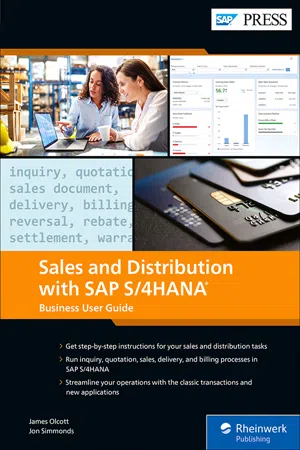
This is a test
- 434 pages
- English
- ePUB (mobile friendly)
- Available on iOS & Android
eBook - ePub
Sales and Distribution with SAP S/4HANA: Business User Guide
Book details
Book preview
Table of contents
Citations
Frequently asked questions
At the moment all of our mobile-responsive ePub books are available to download via the app. Most of our PDFs are also available to download and we're working on making the final remaining ones downloadable now. Learn more here.
Both plans give you full access to the library and all of Perlego’s features. The only differences are the price and subscription period: With the annual plan you’ll save around 30% compared to 12 months on the monthly plan.
We are an online textbook subscription service, where you can get access to an entire online library for less than the price of a single book per month. With over 1 million books across 1000+ topics, we’ve got you covered! Learn more here.
Look out for the read-aloud symbol on your next book to see if you can listen to it. The read-aloud tool reads text aloud for you, highlighting the text as it is being read. You can pause it, speed it up and slow it down. Learn more here.
Yes, you can access Sales and Distribution with SAP S/4HANA: Business User Guide by James Olcott, Jon Simmonds in PDF and/or ePUB format, as well as other popular books in Computer Science & Computer Science General. We have over one million books available in our catalogue for you to explore.
Information
1 Introduction to Sales and Distribution with SAP S/4HANA
SAP is the market-share leader in the enterprise resource planning (ERP) software category. The SAP software suite covers the essential business functions and processes required by an organization to run their businesses. This includes such functions as sales, distribution, manufacturing, warehousing, finance, service, quality management, and human resources, to name just a few.
In this chapter, we’ll investigate the background of SAP as a company and how its technologies and applications grew into the globally recognized brand we see today. From here, we’ll also investigate how sales and distribution has evolved from the hugely popular SAP ERP 6.0 version into the cutting-edge SAP S/4HANA version of today. This section of the book is a reference section only; much of the information that follows is for background purposes and isn’t essential knowledge for the sales and distribution business user.
We’ll then explore the structure of sales and distribution in SAP S/4HANA, from presales documents in the system, flowing right through to billing and accounting.
1.1 The SAP Ecosystem
This initial section provides a brief overview of the history of SAP and how the company moved from a small tech startup to the innovation giant it is today. The details cover the initial tentative steps in the early 1970s, through mainstream establishment in the 1980s to 2000s, and on to the innovative differentiation we see currently.
1.1.1 Origin Story
SAP has a long and successful history in the ERP industry, dating back as far back as 1972 in the early groundbreaking days in the IT sector. Back in those days, five IBM employees left their roles to start up their own company called SAP, initially meaning “Systemanalyse und Programmentwicklung” (System Analysis and Program Development). The first versions of SAP were developed and accepted very quickly at their first client, Imperial Chemicals Industry, providing a standard for business application software featuring real-time data processing.
Initial progress of the fledgling company was slow, but after one year, SAP employed four new employees taking the total to nine, generating DM620,000 in revenue. Two offices were opened in Germany: the headquarters in Weinheim and a nearby office in Mannheim.
As the 1970s progress, SAP as we know it, begins to take shape, starting with the first module—a financial accounting system known as RF. Using DOS on IBM servers, new up-and-coming SAP modules became fully integrated with RF in the coming years to form SAP’s first overarching solution under the name SAP R/1. This full integration of modules became the hallmark of the SAP solution, lending the company its competitive edge in the marketplace.
By 1976, SAP created a sales and support subsidiary—SAP GmbH “Systeme Anwendungen und Produkte in der Datenverarbeitung” (Systems, Applications, and Products in Data Processing). The partnership of SAP GmbH and the original SAP was dissolved eventually in 1981 in favor of SAP GmbH.
Further de...
Table of contents
- Dear Reader
- Notes on Usage
- Table of Contents
- Preface
- 1 Introduction to Sales and Distribution with SAP S/4HANA
- 2 System Prerequisites
- 3 User Navigation
- 4 Presales Inquiries
- 5 Presales Quotations
- 6 Sales Orders
- 7 Delivery
- 8 Billing
- 9 Reversals
- 10 Rebates and Settlement Management
- 11 Warranty and Repairs
- 12 Accounts Receivable
- A Key Transaction Codes
- B SAP Fiori Apps
- C The Authors
- Index
- Service Pages
- Legal Notes